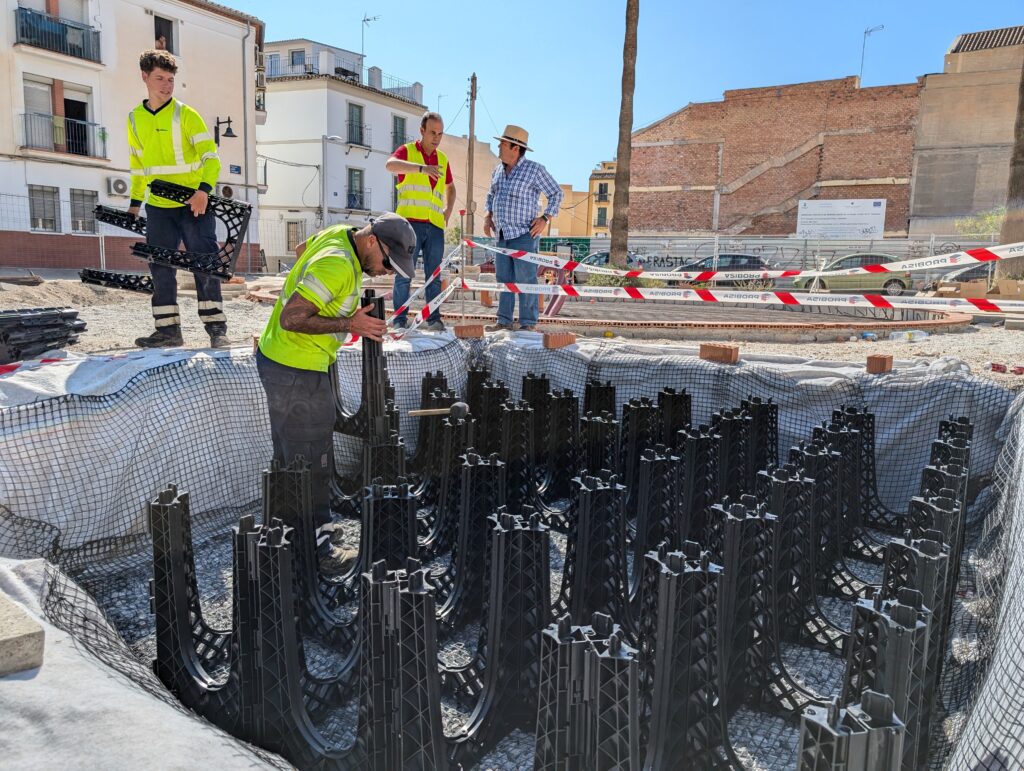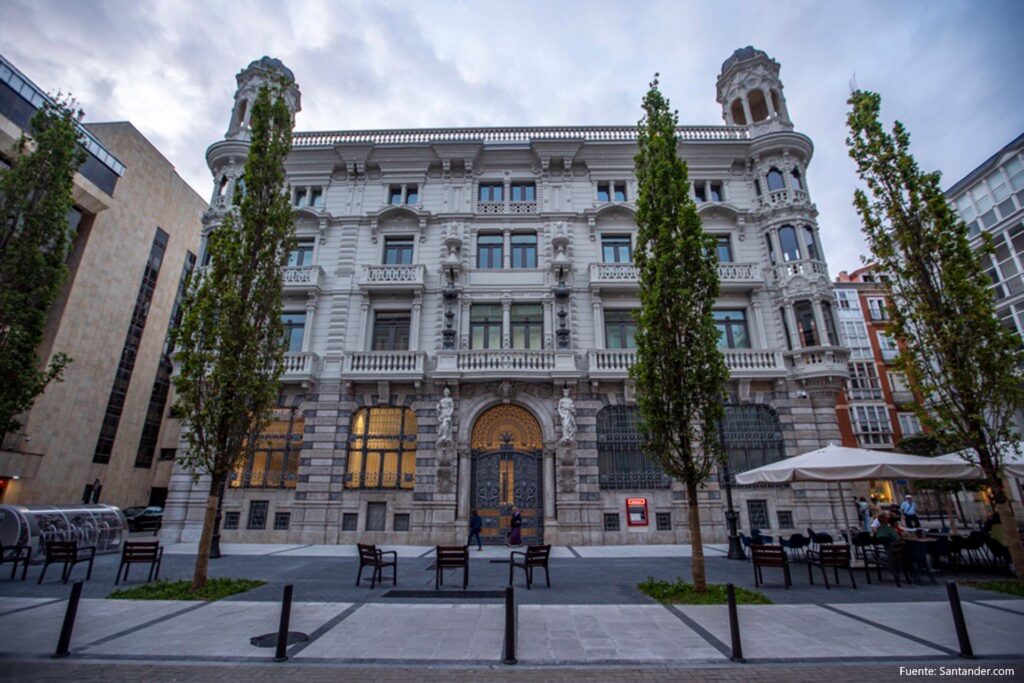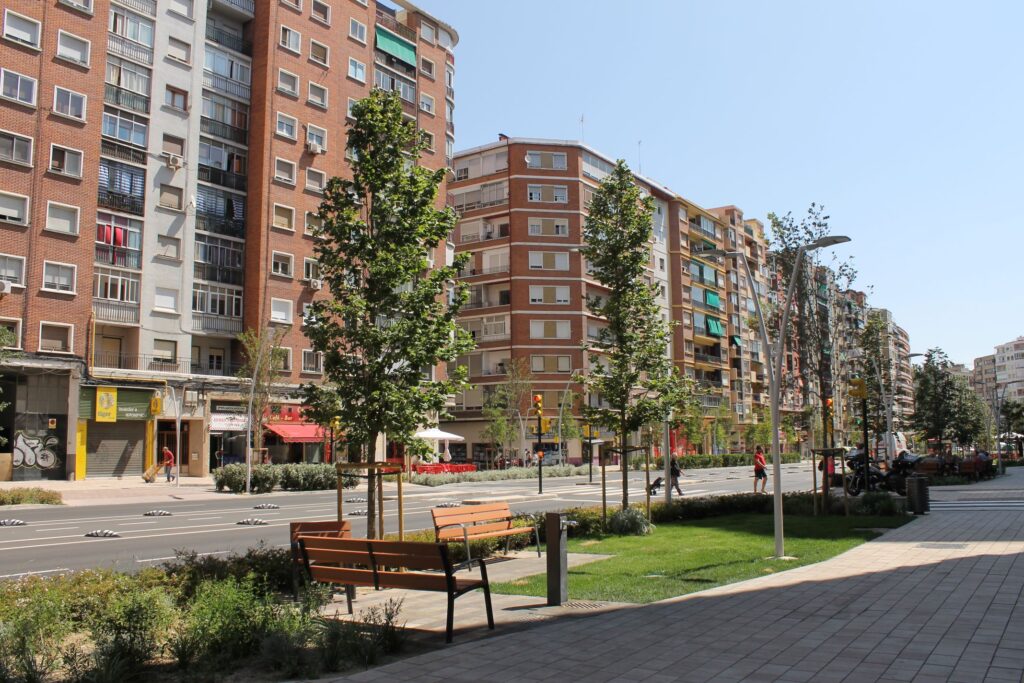The Old Bailey
Two trees were planted during 2004/05 planting season outside the Old Bailey in limited volume tree pits. The tree pits incorporated tree grates, root direction products, irrigation and aeration – and a limited volume of load bearing soil cells at the base of the root direction system. The trees pits were constructed 3.3m square and 1 metre deep. The tree planting location is 11 ft (16.6 m) from the nearest building on the southwest side and the surface around the tree is continuous paved, with a 59” (1500mm) square cast iron tree grate.
The concept here was to provide a high quality start in life for the trees, directing the establishing roots away from vulnerable paved surfaces to reduce the likelihood of paving heave and associated trip hazards. Having been directed downwards to an appropriate level below the paving, the roots grow into the load bearing soil cells which are capable of withstanding heavy loading and vehicle overrun. The cells are not intended in this instance to provide for the complete life of the tree, but to provide a good start – successful establishment and the resource needed to provide, for the roots grow beyond the cell system to locate additional soil volumes.
This type of tree pit is designed for constricted space applications where it is not possible to provide large volume ‘complete life’ soil cell structures.
Inspection Date: September 19, 2013
Inspection Methodology:
Tree was assessed visually, new shoot extension, colour, girth measured
and height calculated. The team then selected five sample leaves from
different aspects of the canopy and these were removed for leaf chlorophyll
fluorescence. The five leaves were tested to arrive at a mean average to
give us a good overall measure of the trees health and vitality.
Results:
Initial visual results were positive. The tree appeared healthy and vigorous with excellent new shoot extension. In the nine years since planting, both trees planted have attained a height of 39 ft (12 m) and a trunk diameter at 5 ft (1.5 m) above ground of 9” (23 cm) dbh (28” or 72cm girth). The Leaf chlorophyll fluorescence mean average reading result was 0.836 – this indicating that the trees are in good health and by this measure not under any significant latent stress. Close assessment of surface surrounding the planting location confirmed that there was no pavement deflection evident at this site attributable to surface root heave.
Conclusion:
The trees studied in this location appear to be growing very well and by our assessment show excellent vigour and health, in a very challenging urban environment. Whilst 9 years is not a large percentage of a trees potential life span, it is encouraging to see that these trees are already bringing significant environmental benefits.
It is also noteworthy that the shallow root deflection means designed into this tree pit had been effective, as the tree had succeeded without the damage to hard surfaces so prevalent around trees in continuous paved surrounds.
Project
Location
Contractor
Landscape Architect
Two trees were planted during 2004/05 planting season outside the Old Bailey in limited volume tree pits. The tree pits incorporated tree grates, root direction products, irrigation and aeration – and a limited volume of load bearing soil cells at the base of the root direction system. The trees pits were constructed 3.3m square and 1 metre deep. The tree planting location is 11 ft (16.6 m) from the nearest building on the southwest side and the surface around the tree is continuous paved, with a 59” (1500mm) square cast iron tree grate.
The concept here was to provide a high quality start in life for the trees, directing the establishing roots away from vulnerable paved surfaces to reduce the likelihood of paving heave and associated trip hazards. Having been directed downwards to an appropriate level below the paving, the roots grow into the load bearing soil cells which are capable of withstanding heavy loading and vehicle overrun. The cells are not intended in this instance to provide for the complete life of the tree, but to provide a good start – successful establishment and the resource needed to provide, for the roots grow beyond the cell system to locate additional soil volumes.
This type of tree pit is designed for constricted space applications where it is not possible to provide large volume ‘complete life’ soil cell structures.
Inspection Date: September 19, 2013
Inspection Methodology:
Tree was assessed visually, new shoot extension, colour, girth measured
and height calculated. The team then selected five sample leaves from
different aspects of the canopy and these were removed for leaf chlorophyll
fluorescence. The five leaves were tested to arrive at a mean average to
give us a good overall measure of the trees health and vitality.
Results:
Initial visual results were positive. The tree appeared healthy and vigorous with excellent new shoot extension. In the nine years since planting, both trees planted have attained a height of 39 ft (12 m) and a trunk diameter at 5 ft (1.5 m) above ground of 9” (23 cm) dbh (28” or 72cm girth). The Leaf chlorophyll fluorescence mean average reading result was 0.836 – this indicating that the trees are in good health and by this measure not under any significant latent stress. Close assessment of surface surrounding the planting location confirmed that there was no pavement deflection evident at this site attributable to surface root heave.
Conclusion:
The trees studied in this location appear to be growing very well and by our assessment show excellent vigour and health, in a very challenging urban environment. Whilst 9 years is not a large percentage of a trees potential life span, it is encouraging to see that these trees are already bringing significant environmental benefits.
It is also noteworthy that the shallow root deflection means designed into this tree pit had been effective, as the tree had succeeded without the damage to hard surfaces so prevalent around trees in continuous paved surrounds.
Proyecto
Ubicación
Contratista
Paisajista
Project
Location
Contractor
Landscape Architect






